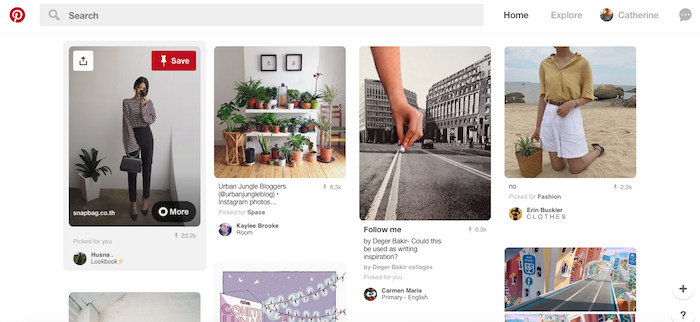Should your startup be on Pinterest?
If you have heard of Pinterest, then chances are you have some assumptions of what it’s about. Weddings featuring candles in jars, gorgeous cakes you could never recreate in a million years, and ideas for perking up your living room – all common themes on Pinterest, but they only scratch the surface. In reality, there are many, many advantages of Pinterest for marketing.
As a form of social media, Pinterest often gets overlooked, possibly because it has a less diverse user base. But marketers who discard Pinterest because they think that it’s solely used by women should take a second look, as the male population on this platform is growing by 40% year on year. Over the past few years, Pinterest has become a powerhouse of imagery that is inspiring users around the globe, so don’t underestimate it.
break-v5
SHOULD YOU HAVE A BUSINESS ACCOUNT?
It can be lucrative
One of the most interesting statistics about this platform is that 85% of weekly Pinners bought from brands they saw on Pinterest. If you are a startup with a product to sell, then this alone should make you consider drawing up a Pinterest marketing strategy. As with all social media platforms, you simply need to look at whether your audience is active on there to make it worth the effort of curating.
For greater insight into the profitability of using Pinterest, check out their 2021 predictions and open letter to their shareholders.
You will need creative direction
As Pinterest is highly visual and is a tool to create mood boards, you will be in a particularly good position to garner interest if your product/service is good-looking, if you have a great eye for design, or if you can afford to hire a creative. For example, if you are in the food industry, you can create boards labelled ‘bottomless brunching’ and ‘healthy breakfast’ that include mouthwatering pins of your edible delicacies. As a general rule, if your startup works particularly well on Instagram, then it will probably transfer to Pinterest too. The key to all this is having consistent branding and enviable, share-worthy images that will make Pinners want to eat, drink, engage with, talk about, and buy your product.
HOW TO USE PINTEREST
Brainstorm boards
Pinterest should be used as a place to collect inspiration on a range of topics. Before using it as a marketing tool, you should sit down with your team and consider the best boards to focus on building. For example, there is no point in pinning images of sunsets if you sell children’s snacks – it just won’t make sense to your audience. Instead, you could have a board dedicated to rainy-day activities for kids or the best child-friendly holidays. It is easy to get boxed into thinking you should only pin highly relevant information (e.g. kid’s meal ideas), but broader thinking will make your profile a one-stop-shop for anyone interested in your industry.
Keep track of the old and new
If your product is continually changing (for example, in the fashion industry), Pinterest can be a great place to view previous products alongside current styles, or to simply update images easily as they evolve. For a clothing line, you could have a pinboard full of images from a promotional photoshoot – while the board might go out of date with the following season, it will serve as a reminder of what might come next year.

BUILDING A FOLLOWING ON PINTEREST
Having a popular profile on Pinterest is a lot harder than on other platforms. Following users is not as common because pinboards are often personal and don’t need much validation in terms of ‘likes’ or ‘shares’ from other profiles. But they can build a large following over time - it just takes patience.
There are two ways to gain influence - the first is by having a popular profile (of course), and the second is by having a popular board (or boards). So how do you achieve this?
Enticing more users to follow you is a similar process to any other social media account. The focus in your activity needs to be:
1. Providing useful and meaningful content
Let this be the focus of your brainstorming sessions. Really get into the psyche of your target audience to figure out what visuals they want to see from you.
2. Engaging with other users
Commenting on pins and adding your own insights to a conversation are ways to be seen as an authority in your space. The more you add value to a platform, the more likely people are to follow in order to see more of the same.
3. Being authentic
To get a large following for a particular board you should aim to pin original, authentic content. If a user sees pins on your board that they have never seen before it will push you up in their esteem. There are themes on Pinterest that recur and lose distinctness as time goes on – if you are out there pinning new imagery on previously unexplored topics that are important to your company, then you are likely to be popular.
If you are consistent in your efforts to be a part of the Pinterest community then you will eventually begin to see results. Consistency is key to maintaining your reputation (otherwise your follower count will just decline), so if you take one piece of startup marketing advice, let it be ‘consistency’.
MONITORING YOUR ACCOUNT
Depending on how active your target market is on Pinterest, your account will probably not need strenuous monitoring. If you login a few times a week and add more pins, then you will be on your way. Take it up a notch by entering conversations and dropping comments around the site to stay involved in goings-on and trending topics. But once you have done the hardest part and fleshed out enough boards to provide ample scroll-time, you will be able to sit back a bit and take a more relaxed approach to Pinterest.
*Editor's note: This blog was originally published in 2017 and has since been updated.
BrighterBox connects the fastest-growing companies with the brightest graduates.
Graduate Jobs



